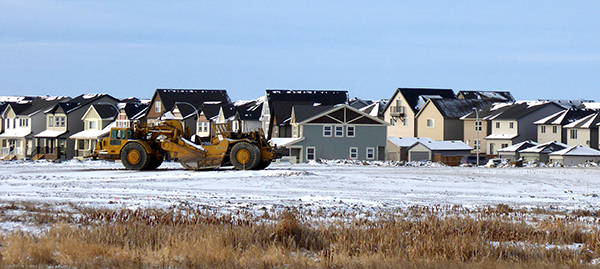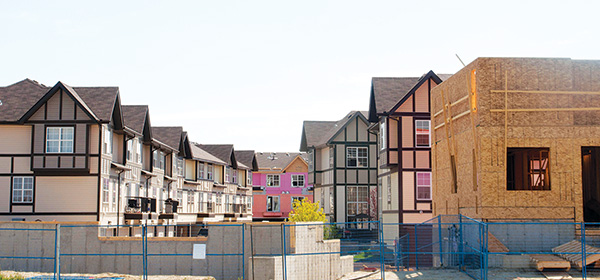
March 11, 2015 | CREBNow
From the ground up
Levy renewal raises questions about community developmentCalgary is familiar with new developments – so much so that the construction crane synonymous with the downtown skyline and beyond has affectionately been referred to as the city's official bird.
Yet, following a closed-door meeting earlier this year where city council agreed to freeze developers' special requests for more suburban land until a new levy agreement can be negotiated later this year, many are questioning how a new project goes from an idea to reality, and who is ultimately paying for it.
The City and suburban developers are currently in the final year of a five-year levy agreement. In 2010, the city increased its development levy to about $315,000 per hectare, doubling the number from the previous agreement. Mayor Naheed Nenshi has since argued current levies are not sufficient in covering the costs of city-provided services, such as pipes and sewage treatment plant expansions.
Urban Development Institute CEO Guy Huntingford said the process to building a new community starts with a developer getting the City of Calgary to approve an Area Structure Plan that provides a template or plan for how the community will evolve and be sub-divided.
From there, the developer applies for an outline plan/land use that provides more details about the community and ensures City services such as water, storm, sanitary, fire and transportation are available. This is typically followed by the developer submitting tentative plans that describing how the community is sub-divided.
"Remember, most communities have many subdivisions (phases) as it takes many years to build out a community," said Huntingford.
Once the design and planning stages are complete, the next step is to put shovels in the ground. For many Calgary communities, this often involves taking the area under development into a clean slate of sorts.
"In general, the first stage of development is to grade the area, ensuring that the topography of lands are shaped and molded to meet the approved plans," said Cam Hart, vice president at Calgary-based Tamani Communities.
This is typically followed by deep servicing. At this stage, the sanitary lines, storm lines and water lines are installed, which enable the homes to have access to these services.
Once that process is complete, the next step is to begin "surface works," which includes all roads, sidewalks and curbs, said Hart.
"Shallow utilities are then installed throughout the subdivision area," he said. "These utilities are comprised of phone lines, street lights, TV cable, gas and electric lines."
Landscaping work on the parks, boulevards and other public areas usually happens around the same time as the shallow utilities. Sod is laid, trees are planted, playgrounds are built and pathways are constructed.
"Home construction usually starts after the surface works are completed and residents will start to move in around four to six months later," said Hart.

When it comes to who bears the financial brunt of adding amenities such as electricity, gas and cable lines, roads, bus stops, water and sewer systems, parks and playgrounds needed to serve such a vast number of homes, Huntingford said the burden is on the developer.
"In terms of risk, the developer bears the cost of 100 per cent of the infrastructure that is inside the community boundaries," he said. "The City and developers (through off-site levies) bear the cost of 'off-site' infrastructure that connects the new community to existing communities, citywide and regional infrastructure (i.e. highways, sewage trunks)."
Largely as a result of the number of new developments that have populated Calgary's outer boundaries, the number of homes in the city has jumped more than 44 per cent over the past years to 478,223 in 2015 from 331,159 in 1999.
To help clarify some of the questions regarding new developments, including the controversial question of who bears the financial burden of such amenities, UDI and the Canadian Home Builders' Association-Calgary recently launched www.smartergrowth.ca.
According to the two groups, developers invest around $17,000 per door toward necessary infrastructure. Taxes and levies are set by the City and are paid by developers to offset "a significant portion" of the connection costs.
Developers are also required to dedicate 10 per cent of developable land to the City for amenities such as parks and schools, and designate approximately 30 per cent of land for utilities and roads.
Hart argued developers' responsibilities have increased over the past decade, including the added responsibility of funding additional amenities such as libraries, fire halls, recreational centres, public art and other community enhancements.
Yet Hart said those added responsibilities ultimately benefit homeowners.
"Developers of new communities tend to retain a greater amount of lands for public use that would be permitted for development, as seen in many communities that exceed the 10 per cent park space requirement," he said.
"Developers are more responsible for the infrastructure in a community as they are now providing longer warranty periods for parks, roads, storm facilities, deep services, etc., before they are turned over to the municipality."
While the City of Calgary was unavailable for comment by press time, a report released last month regarding the city's available land supply showed the number of sub-divided lots (for single-family and semi-detached units) is 6,222, with 14,088 lots with approved land use ready for sub-division.
"The City is working hard on building a stronger relationship with its industry partners," said City Manager Jeff Fielding. "Resolving the lot count debate was central to improving relationships so together we can focus on responding to Calgary's continued growth."
Hart also believes homeowners ultimately benefit from the rigorous approval process to get a community off the ground.
"Approvals have become much more in-depth, with developers taking on increased responsibility to provide additional information prior to a project starting," he said. "This helps to ensure that the future community meets all of the municipality's current policies.
"As the responsibilities increase and change over time, the development and homebuilding industries work to ensure best practices are followed and great communities are built that continue Calgary's legacy of a world class city."
Tagged: Calgary | Calgary Real Estate News | construction | developers




